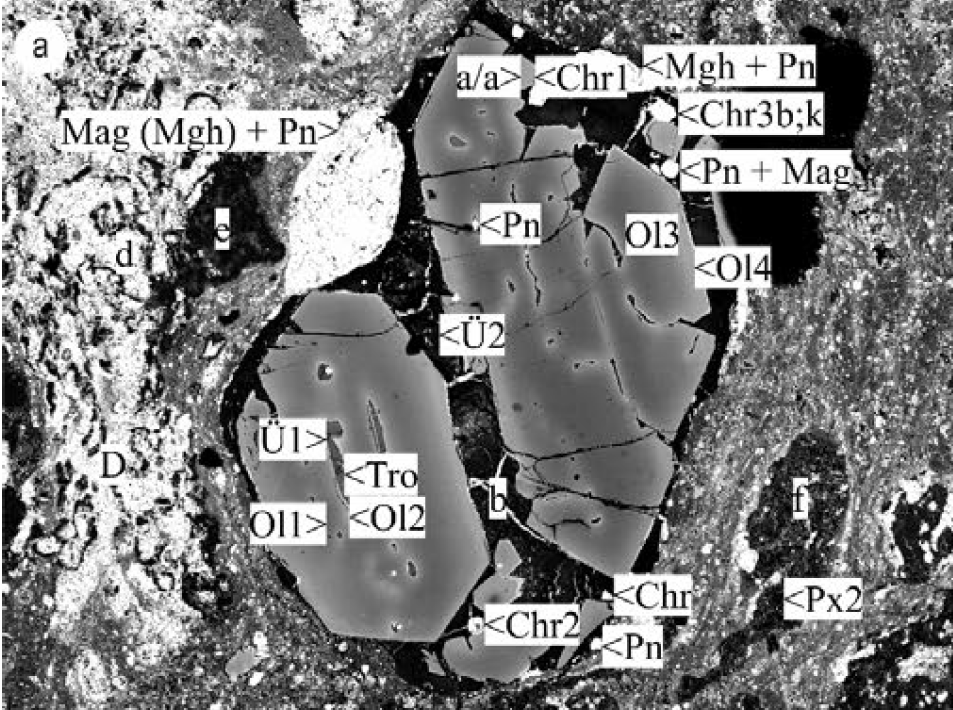Xenocryst associations – xenocrysts in the Kaba CV3 carbonaceous chondrite
Abstract
The highly heterogeneous Kaba meteorite — besides white inclusion aggregates (CAIs), chondrules and a finegrained matrix with organic compounds — also contains xenocryst associations consisting of olivine phenocrysts, spinel group minerals, maghemite (?), and sulphides. Up to now olivin chromite, olivin chromite pyroxene and fayalite sulphide associations have been identified. Apart from these well-defined associations, there are randomly-distributed xenocrysts and chondrule fragments in the meteorite matrix. The most widely spread and characteristic representative of the xenocryst associations consists of olivine and spinel group minerals. It was detected that the chemistry of olivines varies with respect to both zoning and, inhomogenety. Furthermore, there are indications of associations with predominantly either subhedral–anhedral, or euhedral olivines. The phenocrysts are highly cracked, but the surrounding glass or matrix is free of cracks. This may refer to the history of the formation of the cracks: namely, the collision of the parent body, or the impact into the growing parent body. It follows that the minerals of the associations are xenocrysts. The olivines are generally rich in FeO (fayalite component) with considerable zoning: chemically they are mainly hyalosiderites (Fa = 36.1–38.2), while the narrow outer zones are hortonolites–ferrohortonolites (Fa = 54.8, or 53.4–89.7). In the inhomogeneous varieties the differences are smaller: Fa = 22.7–39.4 (chrisolite hyalosiderite). The 100×200 μm dimen sion and hyalosiderite hortonolite composition is surrounded by fragments of impact origin.
There are aluminium iron and chromium spinels in various proportions in the xenocryst associations. In contrast to the aluminium- and magnesium-rich, generally chromium-poor aluminium spinel found in white inclusion aggregates, in the xenocryst associations the spinel group minerals are rich in Cr2O3and FeO (and, albeit rarely, in Fe2O3). As a result, the proportion of chromite in the spinel group minerals is 56–75%. Besides chromite, some aluminium spinel, magnesiochromite, magnetite, and a few examples of ulvite were identified. There is an iron (magnetite) enrichment trend from the core towards the rim in the zoned minerals (with a maximum of 20 mole percent).
The xenocrysts of the fayalite sulphide associations are characterised by frequent cracks, although there is no continuation of this feature in the matrix, or in the sulphides. This may hint to a different formation history.
References
FEGLEY, B. & POST, J. E. 1985: A refractory inclusion in the Kaba CV3 chondrite: some implications for the origin of spinel-rich objects in chondrites. Earth Planet. – Sci. Lett. 75, 297−320. https://doi.org/10.1016/0012-821x(85)90174-8
HEJTMAN, B. 1957: Systematická petrografie vývřelích kornín – Nakl. Českoslov. – Ak. Ved. Praha, 1957.
HUA, X. & BUSECK, P. R. 1995: Fayalite in the Kaba and Mokoia carbonaceous chondrites. – Geochim. et Cosmochim. Acta, 59, 563−578.
HUA, X. & BUSECK, P. R. 1998: Fayalitic halos around inclusions in forsterites from carbonaceous chondrites. – Geochem. et Cosmochem. Acta, 62, 1443−1458. https://doi.org/10.1016/s0016-7037(98)00075-1
KELLER, L. P. & BUSECK, P. R. 1990: Aqueous alteration of the Kaba CV3 carbonaceous chondrite. – Geochem. et Cosmochem. Acta, 54, 2113−2120. https://doi.org/10.1016/0016-7037(90)90274-o
KUBOVICS, I., GÁL-SÓLYMOS, K., DITRÓI-PUSKÁS, Z., BÉRCZI, SZ. 2000: New results from the Kaba meteorite. Part I. Chondrites. – Acta Geol. Hungarica, 43/4, 477−492.
MACPHERSON, G.J., BAR-MATTHEWS, M., TANAKA, T., OLSEN, E., GROSSMAN, L. 1983: Refractory inclusions in the Murchison meteorite. – Geochim. Cosmochim. Acta, 47, 823−839. https://doi.org/10.1016/0016-7037(83)90116-3
MEIBOM, A. & KROT, A. N. 1998: A lithic clast of oxidised CV3 material in the reduced CV3 chondrite breccia Vigarano. – 61st Annual meeting of the Meteoritical Soc.
OLSEN, E. J., DAVIS, A. M., HUTCHEIN, I. D., CLAYTON, R. N., MAYEDA, T. K., GROSSMAN, L. 1988: Murchison xenoliths. – Geochem. et Cosmochem. Acta, 52, 1615−1626. https://doi.org/10.1016/0016-7037(88)90230-x
PECK, J. A. 1984: Origin of the variation on properties of CV3 meteorite matrix and matrix clasts. – Lunar Planet. Sci., XV, 635−636.
WADHWA, M., WEISBERG, M. K., GROZAZ, G., PRINZ, M 1998: Did fayalites in the Kaba CV3 chondrite form in an asteroidal or a nebular environment?: Constraint from Mn-Cr systematics. – LPSC 1998.
















